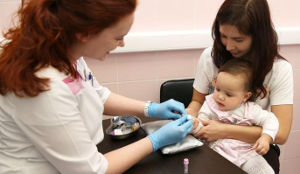Vaccination (insurance) - introduction of antigenic substances to increase their resistance to infectious diseases. According to the WHO Regional Office, routine immunization against influenza, polio, measles, parotite, tetanus and tuberculosis save the health of more than 3 million children worldwide each year. With the development and testing of new vaccines, over 8 million deaths per year will be prevented in the coming years.
Vaccination is what it is and why?
 Vaccines are simple: weakened infectious agents (bacteria, viruses) are introduced into the child ' s system, which are identified by the immune system and are destroyed by immune-competent cells when they are reintroduced.
Vaccines are simple: weakened infectious agents (bacteria, viruses) are introduced into the child ' s system, which are identified by the immune system and are destroyed by immune-competent cells when they are reintroduced.
Not all types of vaccine guarantee 100 per cent protection against infection, but even if it occurs, patients carry the disease easier. Immunobiological drugs against tuberculosis do not protect organisms from infiltration, but contribute to the early destruction and recovery of patients.
Infectious people have over 100 immunization products that are designed to control dozens of different infections. Antigenic materials may be used:
- Living vaccines contain weakened strains of disease-free viruses or bacteria. Protect the organism from polio, rotavirus infection, tuberculosis, measles, windscreen, influenza and rubella;
- Injected vaccines contain killed viruses and bacteria. Used to prevent meningococcal infection, rabies, influenza, hepatitis A, luxury encephalitis and typhoid;
- Toxoids (anatoxins) - laboratory toxins of bacteria. The vaccinations are designed to prevent diphtheria, cough and tetanus.
Less than 3 years ago, molecular vaccines emerged in the pharmaceutical market, containing protein components and other fragments of microbes and viruses. Immunobiological drugs synthetic by genetic engineering techniques prevent the development of hepatitis B and other severe diseases.
Child vaccinations for infectious diseases
Suddenly all types of vaccinations are divided into two groups, mandatory and additional. The first are immunobiological preparations for lethal infectious diseases, and the second is additional for the prevention of diseases with epidemiological evidence.
Immunization takes place from the earliest days of children ' s lives. In the first 24 hours after birth, hepatitis B, a week from tuberculosis, 3 months of life from tetanus, poliomyelitis, cough and diphtheria, six months from hemophilic infection and influenza, a year from parotite, rubber and measles.
The most common preventive vaccinations for children include:
- against gluten encephalitis;
- Pneumococcal infection;
- Against hepatitis A;
- against meningoccal infection.
Prior to children ' s entry into boards, it is recommended that hemophilic, meningococco and pneumoccal infections and the influenza virus be vaccinated.
Immunization analysis
 Before using vaccines, a child should be examined for primary or secondary immunosities. Vaccination cannot be avoided when the organism ' s resistance is reduced, as it may lead to disease and related complications.
Before using vaccines, a child should be examined for primary or secondary immunosities. Vaccination cannot be avoided when the organism ' s resistance is reduced, as it may lead to disease and related complications.
To prevent spinal effects and complications, the immunologist may be assigned the following types of laboratory analyses:
- laboratory and biochemical blood tests;
- Anti-telegnosis test;
- X-ray respiratory survey for lymphdenoid tissue research;
- Immunoglobulin concentration test for 5 classes;
- analysis of the functionality of T-lymphocytes.
In diagnosing the immune deficiency, vaccinations are not performed until the immune system has been rectified. Absorption of anti-indictments is likely to cause serious complications.
Probaza Manto
Manto response (Pirke test) is an internal sample that is used to detect a specific response to the introduction of the tuberculin. The pronounced allergic reaction signals the active interaction of immune-competent cells with the disease-producing agent.
Pirke ' s probe is an immunobiological test that indicates that there is or is not a tuberculosis infection. For the first time, vaccination takes place 12 months after the birth of the child. At the age of 2 years, the procedure is repeated annually, despite the results of last year.
Tuberculodiagnoses, combined with other types of immunization, are not strongly recommended. Between the introduction of various immunobiological drugs, a minimum of 4 to 6 weeks should be observed. When the skin is injected, the sensibilized lymphocytes can be compressed, which is linked to the reaction of sensitized lymphocytes to infiltration of alien agents.
Possible complications
 The planned vaccination of a child should not be accepted in the absence of allergency testing and analysis. Hypertensive treatment of components of drugs and reduced reactive organisms can lead to complications such as:
The planned vaccination of a child should not be accepted in the absence of allergency testing and analysis. Hypertensive treatment of components of drugs and reduced reactive organisms can lead to complications such as:
- Polio;
- elevated temperature;
- Queenke glass;
- Burning on the skin;
- Anaphylactic reactions;
- Boat;
- Polyevrit;
- Arthritis;
- encephalopathy;
- Serum disease syndrome;
- encephalitis.
The generalization of the Tuberculosis Producer leads to severe inflammation of bone tissues and the development of complications. In a number of cases, children have experienced violations by CNS that result in disability.
Against vaccination
When making immunobiological preparations, the paediatrician must take into account the physical integrity of the child. The introduction of vaccines without immune status resulted in immune equilibrium, thus creating favourable conditions for the development of infections.
Immunization of children can only be done if they are perfectly healthy. Vaccinations are largely dependent on the type of vaccination, among the most common:
- Tuberculosis vaccination (BCD) - skin inflammation, intrauterine infections and immunodefficiency (TB injection);
- polio vaccinations are neurological disorders, acute infectious diseases, infantry tumours;
- Adsorbed coclusive-diphtherine-style vaccine (ACDF) - meningitis, vasculitis, allergies, febrile fever, myocardite, intoxication;
- Influenza vaccinations - Chronic disease exacerbation, smoking squirrels allergy, hypersensitive to existing substances.
Conclusion
Vaccination is an effective means of preventing the development of severe diseases in children. However, vaccinations are recommended only if there is no health problem, especially acute infectious diseases. In order to prevent complications, the immunization of various drugs must be carried out at 4 or 6 weeks intervals.
div id="nap_form_footer" style="margin-top: 40px;"state == sync, corrected by elderman == @elder_man == sync, corrected by elderman == @elder_man == sync, corrected by elderman == @elder_man Any questions? PER/div constituent == sync, corrected by elderman == @elder_man We're happy to answer them. PER/div constituent " : PER/div constituent duct/section constituent PER/div constituent == sync, corrected by elderman == @elder_man $(document).ready(function(){ If('*[data-fancybox="form-nap"]'.length constituent0) $('#nap_form_footer. ♪ ♪ PER/script